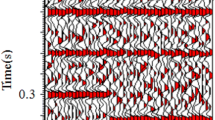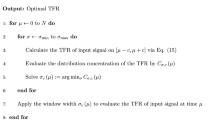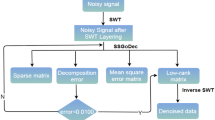Abstract
In seismic data processing, low-frequency random noise with non-Gaussian and non-stationary characteristics heavily contaminates the reflected signals in Tarim area, which brings great difficulties in interpretation of seismic records in northwest China. To achieve more satisfied resolution, more greater fidelity, together with much higher increased signal-to-noise ratio (SNR), this paper proposes a SNR enhancement method based on the combination of variational mode decomposition (VMD) and Semi-soft Go Decomposition (Semi-Soft GoDec), named VMD-SSGoDec, which can realize the simplification of low-rank extraction in time–frequency representation (TFR) domain. Firstly, each trace of the rough seismic record is decomposed into several modes to reconstruct a component matrix by VMD. Due to the semi-low rank or approximate low-rank character of the desert low-frequency noise component matrix in TFR domain, secondly, we apply the Semi-soft GoDec, a low-rank matrix estimation to extract the low-frequency random noise components from the VMD results obtained in the first step. Repeating the above single-trace procedure to each trace rather than decomposing the entire record but use low-rank estimation once can lead to a more reduced dimension of the component matrix, and thus simplify the low-rank selection in Semi-soft GoDec. Finally, with the extracted random noise results in the second step, we can obtain the denoised record by making a difference with the original input. The proposed algorithm is tested by both synthetic record and field desert seismic data. Experimental results show outstanding advantages in low-frequency noise attenuation comparing with those of f-x deconvolution and SSWT-OptShrink. Both low-frequency random noise and surface waves are almost thoroughly attenuated by the proposed method, while the reflected signals are left nearly intact, revealing a significant enhancement in SNR.







Similar content being viewed by others
References
Abma, R., & Claerbout, J. (1995). Lateral prediction for noise attenuation by t-x and f-x techniques. Geophysics, 60(6), 1887–1896.
Anvari, R., Siahsar, M. A. N., Gholtashi, S., Roshandel Kahoo, A., & Mohammadi, M. (2017). Seismic random noise attenuation using synchrosqueezed wavelet transform and low-rank signal matrix approximation. IEEE Transactions on Geoscience and Remote Sensing, 55(11), 6574–6581.
Daubechies, I., Lu, J., & Wu, H. (2011). Synchrosqueezed wavelet transforms: an empirical mode decomposition-like tool. Applied and Computational Harmonic Analysis, 30(2), 243–261.
Dragomiretskiy, K., & Zosso, D. (2014). Variational mode decomposition. IEEE Transactions on Signal Processing, 62(3), 531–544.
Gu, S., Zhang, L., Zuo, W., & Feng, X. (2014). Weighted nuclear norm minimization with application to image denoising. Paper presented at the 2862–2869.
Li, G., & Li, Y. (2016). Random noise of seismic exploration in desert modeling and its applying in noise attenuation. Chinese Journal of Geophysics (acta Geophysica Sinica), 59(2), 682–692.
Ma, H., Yan, J., Li, Y., Zhang, C., & Lin, H. (2019). Desert seismic random noise reduction based on LDA effective signal detection. Acta Geophysica, 67(1), 109–121.
Ma, H., Yan, J., & Li, Y. (2020). Low-frequency noise suppression of desert seismic data based on variational mode decomposition and low-rank component extraction. IEEE Geoscience and Remote Sensing Letters, 17(2), 337–341.
Majumder, S., & Kanjilal, P. P. (2019). Application of singular spectrum analysis for investigating chaos in sea surface temperature. Pure and Applied Geophysics, 176(8), 3769–3786.
Mousavi, S. M., & Langston, C. A. (2017). Automatic noise-removal/signal-removal based on general cross-validation thresholding in synchrosqueezed domain and its application on earthquake data. Geophysics, 82(4), V211–V227.
Mousavi, S. M., Langston, C. A., & Horton, S. P. (2016). Automatic microseismic denoising and onset detection using the synchrosqueezed continuous wavelet transform. Geophysics, 81(4), V341–V355.
Nazari Siahsar, M. A., Gholtashi, S., Kahoo, A. R., Marvi, H., & Ahmadifard, A. (2016). Sparse time-frequency representation for seismic noise reduction using low-rank and sparse decomposition. Geophysics, 81(2), V31–V38.
Oropeza, V., & Sacchi, M. (2011). Simultaneous seismic data denoising and reconstruction via multichannel singular spectrum analysis. Geophysics, 76(3), V25–V32.
Spitz, S., & Deschizeaux, B. (1994). Random noise attenuation in data volumes FXY predictive filtering versus a signal subspace technique, 56th Annual Conference and Exhibition, EAGE, Extended Abstracts, H033.
Wang, X., Lü, J., Xie, Z., Long, F., Zhao, X., & Zheng, Y. (2015). Focal mechanisms and tectonic stress field in the north-south seismic belt of china. Chinese Journal of Geophysics (acta Geophysica Sinica), 58(11), 4149–4162.
Wright, J., Peng, Y., Ma, Y., Ganesh, A., & Rao, S. (2009). Robust principal component analysis: exact recovery of corrupted low-rank matrices by convex optimization. Advances in Neural Information Processing Systems 22 - Proceedings of the 2009 Conference, 2080–2088.
Xu, P., Ren, Y., Wen, R., & Wang, H. (2020). Observations on regional variability in ground-motion amplitude from six M-w ~ 6.0 earthquakes of the north-south seismic zone in China. Pure and Applied Geophysics, 177(1), 247–264.
Zhou, T., & Tao, D. (2011). GoDec: Randomized low-rank & sparse matrix decomposition in noisy case. Proceedings of the 28th international conference on machine learning, 33–40.
Zhou, T., & Tao, D. (2013). Shifted subspaces tracking on sparse outlier for motion segmentation. IJCAI international joint conference on artificial intelligence. 1946–1952.
Acknowledgements
This work is supported by the National Natural Science Foundation of China (Grant 41730422).
Author information
Authors and Affiliations
Corresponding author
Additional information
Publisher's Note
Springer Nature remains neutral with regard to jurisdictional claims in published maps and institutional affiliations.
Rights and permissions
About this article
Cite this article
Wu, N., Li, Y., Yan, J. et al. A SNR Enhancement Method for Desert Seismic Data: Simplified Low-Rank Selection in Time–Frequency Decomposition Domain. Pure Appl. Geophys. 178, 2905–2916 (2021). https://doi.org/10.1007/s00024-021-02789-w
Received:
Revised:
Accepted:
Published:
Issue Date:
DOI: https://doi.org/10.1007/s00024-021-02789-w




